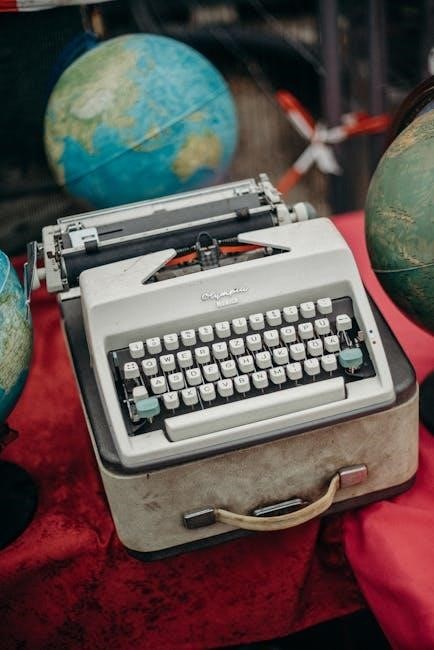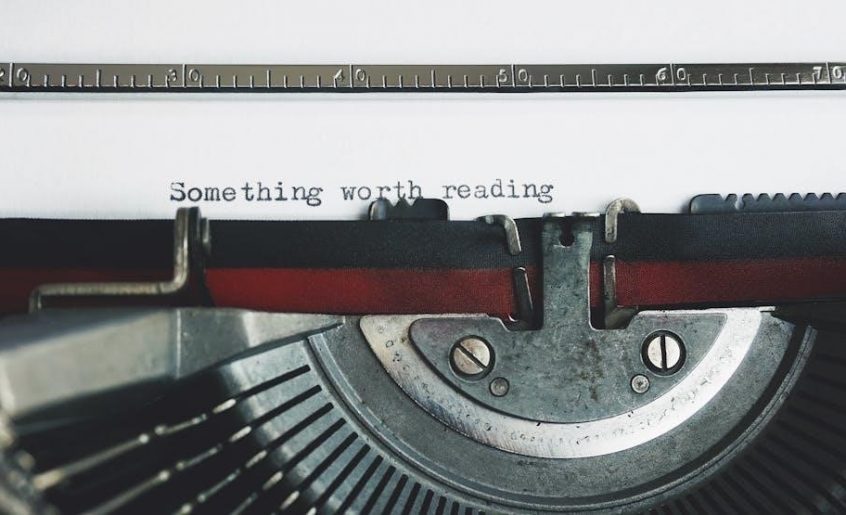Manual lensometry is a precise optical technique for measuring lens prescriptions‚ ensuring accurate eyewear adjustments. It remains essential in optometry for verifying lens power and alignment‚ blending tradition with modern eye care needs.
What is Manual Lensometry?
Manual lensometry involves using a lensometer to measure the optical properties of lenses‚ such as sphere‚ cylinder‚ axis‚ and prism. It is a precise‚ hands-on process requiring skill and understanding of optical principles. The lensometer aligns the lens for accurate readings‚ ensuring the prescription matches the eyewear. This method is vital in optometry for verifying lens accuracy and addressing complex prescriptions effectively.
Importance of Manual Lensometry in Optometry
Manual lensometry is crucial for ensuring accuracy in eyewear prescriptions‚ especially for complex lenses. It provides reliable measurements of sphere‚ cylinder‚ axis‚ and prism‚ essential for correcting vision. Optometrists and opticians rely on manual lensometry to verify lens parameters‚ address alignment issues‚ and adapt to unique patient needs‚ making it a cornerstone of precise and personalized eye care delivery.

History and Evolution of Lensometry
Lensometry originated in the early 20th century‚ evolving from basic optical tools to advanced devices. Innovations in materials and technology have refined its accuracy and usability over time.
Development of the First Lensometers
The first lensometers emerged in the early 20th century‚ evolving from basic optical tools. Initially‚ they were simple mechanical devices designed to measure lens power and align optical centers. These early versions relied on manual adjustments‚ requiring skill for precise measurements. Opticians and early optometrists played a crucial role in refining their design‚ enhancing functionality. This innovation laid the foundation for modern optometry.
Modern Advances in Lensometry Technology
Modern lensometers feature digital integration‚ automation‚ and enhanced precision. Portable‚ compact designs improve accessibility‚ while advanced software streamlines measurements. Automated models reduce human error‚ offering faster and more accurate results. These innovations ensure consistency and efficiency‚ making lensometry indispensable in contemporary optometry. The integration of wireless connectivity and data storage further enhances functionality‚ catering to evolving eye care demands.
Types of Lensometers
Lensometers are categorized into manual‚ automated‚ and portable models. Manual lensometers require skill and precision‚ while automated versions offer speed and accuracy. Portable options provide convenience and affordability.
Manual Lensometers
Manual lensometers are optical instruments requiring skill and precision to measure lens power‚ cylinder axis‚ and optical center. They involve focusing a reticle to match lens markings‚ ensuring accurate readings. Widely used in optometry‚ they are essential for verifying prescriptions and adjusting eyewear. While they demand practice‚ manual lensometers remain cost-effective and reliable for precise measurements in clinical and laboratory settings.
Automated Lensometers
Automated lensometers offer advanced‚ rapid measurement of lens power‚ cylinder‚ and axis with minimal user input. Utilizing digital technology‚ these devices improve efficiency and reduce errors. They are ideal for high-volume practices‚ providing precise results quickly. While they require initial investment‚ automated lensometers enhance productivity and accuracy in modern optometry‚ complementing traditional manual methods with cutting-edge innovation for optimal patient care and streamlined workflows.
Portable and Compact Lensometers
Portable and compact lensometers are lightweight‚ easy-to-use devices designed for on-the-go measurements. They are ideal for optometrists and opticians working in field settings or small practices. These devices offer cost-effective solutions‚ combining accuracy with portability. Compact lensometers are versatile‚ measuring lens power‚ cylinder‚ and axis efficiently. They are perfect for professionals needing reliable‚ space-saving tools without compromising on performance or precision in eyewear adjustments and prescriptions.
Understanding the Optics Behind Manual Lensometry
Manual lensometry relies on refraction principles to measure lens power‚ cylinder‚ and axis‚ ensuring accurate optical center alignment for precise eyewear adjustments and prescription verification.
Refraction and Lens Power Measurement
Manual lensometry measures lens power by analyzing light refraction through the lens. The lensometer focuses a reticle pattern to determine spherical and cylindrical powers‚ ensuring accurate prescription readings. This process involves aligning the lens properly and adjusting the device to achieve sharp focus‚ which is critical for obtaining precise optical measurements; The principles of refraction guide the calculation of lens strength‚ ensuring reliable results for eyewear adjustments.
Cylinder Axis and Optical Center Determination
Manual lensometry involves determining the cylinder axis by aligning the lensometer’s reticle with the lens’s cylindrical power. The axis is identified by rotating the lens until the reticle aligns with the cylinder’s orientation‚ ensuring accurate astigmatism correction. The optical center is found by centering the lens on the lensometer stage‚ ensuring proper alignment for precise measurements. Accurate determination of these elements is crucial for correct lens performance.
Principles of Algebraic Addition in Lensometry
Algebraic addition in manual lensometry involves combining spherical and cylindrical powers to determine the total lens power. This principle ensures accurate calculation of prism and axis alignment‚ crucial for correcting astigmatism and ensuring proper lens performance. By applying these mathematical principles‚ opticians can precisely measure and adjust lenses‚ ensuring optimal vision correction for patients with complex prescriptions.

Step-by-Step Process of Manual Lensometry
Manual lensometry involves positioning eyewear on the lensometer‚ focusing the reticle for clarity‚ and measuring spherical power‚ cylinder axis‚ and optical center to interpret the prescription accurately.
Positioning the Eyewear on the Lensometer
Accurate positioning of eyewear on the lensometer is crucial. Place the glasses on the device’s stage‚ ensuring the lenses are centered and secure. Align the lens’s optical center with the lensometer’s aperture for precise measurement. Proper alignment prevents errors in reading spherical power‚ cylinder axis‚ and prism. This step ensures reliable data for interpreting the prescription correctly.
Focusing the Reticle for Accurate Measurements
Focusing the reticle is critical for precise lens measurements. Rotate the power drum to a high plus setting‚ then adjust until the reticle lines appear sharp. Fine-tune the focus using the eyepiece diopter to ensure clarity. Proper alignment ensures accurate sphere‚ cylinder‚ and axis readings. Misalignment can lead to errors‚ so careful adjustment is essential for reliable results.
Reading and Interpreting the Prescription
Reading the lensometer involves aligning the reticle lines with the lens’s focal points. The sphere power is read first‚ followed by the cylinder and axis. Ensure the reticle lines are sharp and centered to avoid errors. Proper alignment is key to accurate measurements. The prescription is interpreted by matching the reticle’s markings with the lens’s optical center‚ ensuring precise results for eyewear adjustments.
Common Challenges in Manual Lensometry
Common challenges include misalignment of the cylinder and axis‚ difficulty in identifying the optical center‚ and maintaining focus for precise readings‚ requiring skill and attention to detail.
Troubleshooting Difficulties in Measurement
Common measurement difficulties include misalignment of the cylinder axis or optical center. To address this‚ ensure the reticle is focused clearly and adjust the lensometer’s cylinder axis scale. Start with high plus powers to neutralize the lens‚ then gradually refine. Proper positioning of the eyewear and calibration of the device are crucial for accurate results. Patience and a systematic approach minimize errors.
Addressing Cylinder and Axis Misalignment
When encountering cylinder and axis misalignment‚ ensure the lens is properly centered on the lensometer. Use the cylinder axis scale to align the reticle with the lens’s markings. Neutralize the plus meridian first by adjusting the power drum. Fine-tune the axis by rotating the cylinder knob until the reticle lines match the lens’s orientation. Accuracy in alignment ensures correct prescription readings and proper optical center identification.
Overcoming Optical Center Identification Issues
To accurately identify the optical center‚ ensure the lens is properly aligned on the lensometer. Focus the reticle sharply and check for any debris or smudges on the lens surface. Use the lensometer’s built-in markings to guide alignment. If issues persist‚ rotate the lens slightly and re-measure. Ensuring the optical center is correctly identified is crucial for accurate prescription readings and proper lens alignment.
- Verify lens cleanliness before measurement.
- Use the lensometer’s alignment guides for precision.
- Recheck focus and positioning if misalignment occurs.

The Role of Manual Lensometry in Modern Optometry
Manual lensometry remains vital for verifying lens prescriptions and adjustments‚ ensuring accuracy in eyewear. It complements automated systems‚ offering a reliable method for optometrists to confirm optical measurements precisely.
Why Manual Skills Remain Relevant Today
Manual lensometry skills are still crucial in modern optometry‚ as they ensure precise measurements and serve as a reliable backup when automated systems fail. Understanding manual techniques allows opticians to verify prescriptions accurately and address complex cases effectively‚ maintaining high standards of eye care delivery.
Comparison with Automated Lensometry
Manual lensometry offers precision and reliability‚ serving as a vital backup to automated systems. While automated lensometers are faster and reduce human error‚ manual techniques ensure accuracy in complex cases and when technology fails. Both methods complement each other‚ blending tradition with innovation to meet modern optometry demands.

Best Practices for Accurate Manual Lensometry
Regular calibration and proper eyewear positioning are crucial. Use reference points for alignment‚ ensure reticle clarity‚ and maintain focus for precise measurements‚ enhancing reliability and consistency.
Calibration and Maintenance of the Lensometer
Proper calibration ensures accurate measurements. Use reference lenses to verify zero points and alignment. Regularly clean the lensometer’s optical surfaces and check reticle focus. Store the device securely to prevent damage. Maintain mechanical components to avoid wear-induced errors. Schedule professional servicing periodically for optimal performance. Neglecting maintenance can lead to inaccurate readings‚ emphasizing the importance of routine checks and adherence to manufacturer guidelines.
Tips for Consistent and Reliable Measurements
Ensure the eyewear is properly positioned on the lensometer for accurate readings. Use the reticle focus to achieve clarity before measuring. Start with the right lens and proceed to the left for consistency. Neutralize the most plus meridian first when cylinder power is present. Rotate counterclockwise until the reticle blurs‚ then adjust clockwise for clarity. Always record measurements systematically to avoid errors and ensure precision in interpreting prescriptions. Patience and attention to detail are crucial for reliable results.
